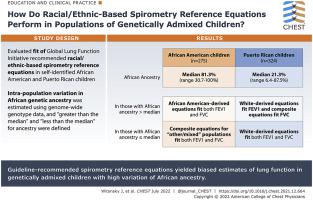Chest ( IF 9.5 ) Pub Date : 2022-01-13 , DOI: 10.1016/j.chest.2021.12.664 Jonathan Witonsky 1 , Jennifer R Elhawary 2 , Celeste Eng 2 , José R Rodríguez-Santana 3 , Luisa N Borrell 4 , Esteban G Burchard 5

|
Background
Variation in genetic ancestry among genetically admixed racial and ethnic groups may influence the fit of guideline-recommended spirometry reference equations, which rely on self-identified race and ethnicity.
Research Question
What is the influence of genetic ancestry on the fit of race- and ethnicity-based spirometry reference equations in populations of genetically admixed children?
Study Design and Methods
Cross-sectional fit of guideline-recommended race- and ethnicity-based spirometry reference equations was evaluated in healthy control participants from case-control studies of asthma. Anthropometry, blood samples, and spirometric measurements were obtained for 599 genetically admixed children 8 to 21 years of age. Genetic ancestry was estimated using genome-wide genotype data. Equation fit, measured as a mean z score, was assessed in self-identified African American (n = 275) and Puerto Rican (n = 324) children as well as genetic ancestry-defined strata of each population.
Results
For African American children, African American-derived equations fit for predicting FEV1 and FVC in those with an African ancestry more than the median (81.4%-100.0%), whereas composite equations for “other/mixed” populations fit for predicting FEV1 and FVC in those with African ancestry at or less than the median (30.7%-81.3%). For Puerto Rican children with African ancestry at or less than the median (6.4%-21.3%), White-derived equations fit both FEV1 and FVC, whereas for those with African ancestry more than the median (21.4%-87.5%), White-derived equations fit the FEV1 and the composite equations fit the FVC.
Interpretation
Guideline-recommended spirometry reference equations yielded biased estimates of lung function in genetically admixed children with high variation of African ancestry. Spirometry could benefit from reference equations that incorporate genetic ancestry, either for more precise application of the current equations or the derivation and use of new equations.
中文翻译:

基于种族和民族的肺活量测定参考方程
背景
基因混合的种族和族裔群体之间遗传血统的变异可能会影响指南推荐的肺活量测定参考方程的拟合度,该方程依赖于自我识别的种族和民族。
研究问题
在遗传混合儿童群体中,遗传血统对基于种族和民族的肺活量测定参考方程的拟合有什么影响?
研究设计和方法
在哮喘病例对照研究的健康对照参与者中评估了指南推荐的基于种族和民族的肺活量测定参考方程的横截面拟合。对 599 名 8 至 21 岁的基因混合儿童进行了人体测量、血液样本和肺活量测量。使用全基因组基因型数据估计遗传祖先。方程拟合度以平均z分数衡量,在自我认定的非裔美国人 (n = 275) 和波多黎各人 (n = 324) 儿童以及每个人群的遗传血统定义的阶层中进行评估。
结果
对于非裔美国儿童,非裔美国人导出的方程适合预测非洲血统高于中位数 (81.4%-100.0%) 的FEV 1和 FVC,而“其他/混合”人群的复合方程适合预测 FEV 1非洲血统的 FVC 等于或低于中位数 (30.7%-81.3%)。对于非洲血统等于或低于中位数 (6.4%-21.3%) 的波多黎各儿童,White 导出的方程同时适合 FEV 1和 FVC,而对于非洲血统高于中位数 (21.4%-87.5%) 的儿童, White 导出的方程适合 FEV 1,复合方程适合 FVC。
解释
指南推荐的肺活量测定参考方程对具有高度非洲血统的基因混合儿童的肺功能产生了有偏差的估计。肺活量测定法可以受益于包含遗传血统的参考方程,无论是为了更精确地应用当前方程还是推导和使用新方程。











































 京公网安备 11010802027423号
京公网安备 11010802027423号